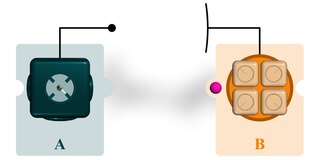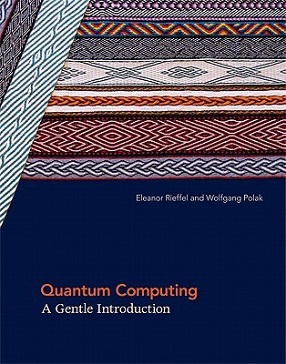In physics, the no-cloning theorem states that it is impossible to create an independent and identical copy of an arbitrary unknown quantum state, a statement which has profound implications in the field of quantum computing among others. The theorem is an evolution of the 1970 no-go theorem authored by James Park, in which he demonstrates that a non-disturbing measurement scheme which is both simple and perfect cannot exist. The aforementioned theorems do not preclude the state of one system becoming entangled with the state of another as cloning specifically refers to the creation of a separable state with identical factors. For example, one might use the controlled NOT gate and the Walsh–Hadamard gate to entangle two qubits without violating the no-cloning theorem as no well-defined state may be defined in terms of a subsystem of an entangled state. The no-cloning theorem concerns only pure states whereas the generalized statement regarding mixed states is known as the no-broadcast theorem.

A quantum computer is a computer that takes advantage of quantum mechanical phenomena.

Quantum information is the information of the state of a quantum system. It is the basic entity of study in quantum information theory, and can be manipulated using quantum information processing techniques. Quantum information refers to both the technical definition in terms of Von Neumann entropy and the general computational term.

Quantum teleportation is a technique for transferring quantum information from a sender at one location to a receiver some distance away. While teleportation is commonly portrayed in science fiction as a means to transfer physical objects from one location to the next, quantum teleportation only transfers quantum information. The sender does not have to know the particular quantum state being transferred. Moreover, the location of the recipient can be unknown, but to complete the quantum teleportation, classical information needs to be sent from sender to receiver. Because classical information needs to be sent, quantum teleportation cannot occur faster than the speed of light.

In quantum computing, a qubit or quantum bit is a basic unit of quantum information—the quantum version of the classic binary bit physically realized with a two-state device. A qubit is a two-state quantum-mechanical system, one of the simplest quantum systems displaying the peculiarity of quantum mechanics. Examples include the spin of the electron in which the two levels can be taken as spin up and spin down; or the polarization of a single photon in which the two spin states can also be measured as horizontal and vertical linear polarization. In a classical system, a bit would have to be in one state or the other. However, quantum mechanics allows the qubit to be in a coherent superposition of multiple states simultaneously, a property that is fundamental to quantum mechanics and quantum computing.
Quantum key distribution (QKD) is a secure communication method that implements a cryptographic protocol involving components of quantum mechanics. It enables two parties to produce a shared random secret key known only to them, which then can be used to encrypt and decrypt messages. The process of quantum key distribution is not to be confused with quantum cryptography, as it is the best-known example of a quantum-cryptographic task.
This is a timeline of quantum computing.
Theoretical computer science (TCS) is a subset of general computer science and mathematics that focuses on mathematical aspects of computer science such as the theory of computation (TOC), formal language theory, the lambda calculus and type theory.
In quantum information science, the Bell's states or EPR pairs are specific quantum states of two qubits that represent the simplest examples of quantum entanglement. The Bell's states are a form of entangled and normalized basis vectors. This normalization implies that the overall probability of the particle being in one of the mentioned states is 1: . Entanglement is a basis-independent result of superposition. Due to this superposition, measurement of the qubit will "collapse" it into one of its basis states with a given probability. Because of the entanglement, measurement of one qubit will "collapse" the other qubit to a state whose measurement will yield one of two possible values, where the value depends on which Bell's state the two qubits are in initially. Bell's states can be generalized to certain quantum states of multi-qubit systems, such as the GHZ state for three or more subsystems.
Pieter Kok is a Dutch physicist and one of the co-developers of quantum interferometric optical lithography.
Quantum networks form an important element of quantum computing and quantum communication systems. Quantum networks facilitate the transmission of information in the form of quantum bits, also called qubits, between physically separated quantum processors. A quantum processor is a machine able to perform quantum circuits on a certain number of qubits. Quantum networks work in a similar way to classical networks. The main difference is that quantum networking, like quantum computing, is better at solving certain problems, such as modeling quantum systems.
The Centre for Quantum Technologies (CQT) in Singapore is a Research Centre of Excellence hosted by the National University of Singapore. The Centre brings together physicists, computer scientists and engineers to do basic research on quantum physics and to build devices based on quantum phenomena. Experts in quantum technologies are applying their discoveries in computing, communications and sensing.
Quantum cryptography is the science of exploiting quantum mechanical properties to perform cryptographic tasks. The best known example of quantum cryptography is quantum key distribution, which offers an information-theoretically secure solution to the key exchange problem. The advantage of quantum cryptography lies in the fact that it allows the completion of various cryptographic tasks that are proven or conjectured to be impossible using only classical communication. For example, it is impossible to copy data encoded in a quantum state. If one attempts to read the encoded data, the quantum state will be changed due to wave function collapse. This could be used to detect eavesdropping in quantum key distribution (QKD).
The DiVincenzo criteria are conditions necessary for constructing a quantum computer, conditions proposed in 2000 by the theoretical physicist David P. DiVincenzo, as being those necessary to construct such a computer—a computer first proposed by mathematician Yuri Manin, in 1980, and physicist Richard Feynman, in 1982—as a means to efficiently simulate quantum systems, such as in solving the quantum many-body problem.
In quantum computing, quantum supremacy or quantum advantage is the goal of demonstrating that a programmable quantum computer can solve a problem that no classical computer can solve in any feasible amount of time, irrespective of the usefulness of the problem. The term was coined by John Preskill in 2012, but the concept dates to Yuri Manin's 1980 and Richard Feynman's 1981 proposals of quantum computing.
Continuous-variable (CV) quantum information is the area of quantum information science that makes use of physical observables, like the strength of an electromagnetic field, whose numerical values belong to continuous intervals. One primary application is quantum computing. In a sense, continuous-variable quantum computation is "analog", while quantum computation using qubits is "digital." In more technical terms, the former makes use of Hilbert spaces that are infinite-dimensional, while the Hilbert spaces for systems comprising collections of qubits are finite-dimensional. One motivation for studying continuous-variable quantum computation is to understand what resources are necessary to make quantum computers more powerful than classical ones.

Giacomo Mauro D'Ariano is an Italian quantum physicist. He is a professor of theoretical physics at the University of Pavia, where he is the leader of the QUIT group. He is a member of the Center of Photonic Communication and Computing at Northwestern University; a member of the Istituto Lombardo Accademia di Scienze e Lettere; and a member of the Foundational Questions Institute (FQXi).

Quantum Computing: A Gentle Introduction is a textbook on quantum computing. It was written by Eleanor Rieffel and Wolfgang Polak, and published in 2011 by the MIT Press.
Mark McMahon Wilde is an American quantum information scientist. He is an Associate Professor in the School of Electrical and Computer Engineering at Cornell University, and he is also a Fields Member in the School of Applied and Engineering Physics and the Department of Computer Science at Cornell.
This glossary of quantum computing is a list of definitions of terms and concepts used in quantum computing, its sub-disciplines, and related fields.






